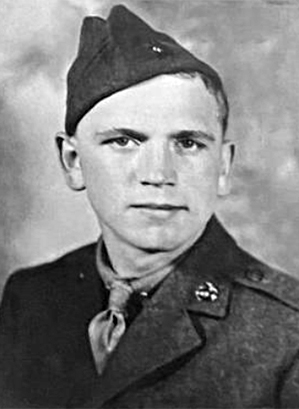Glenn Franklin White
PFC Glenn F. White served with Able Company, First Battalion, 6th Marines.
He was killed in action at the battle of Tarawa on 22 November 1943.
Branch
Marine Corps Regular
Service Number 371100
Current Status
Accounted For
as of 7 June 2021
Recovery Organization
History Flight 2019 Expedition
Read DPAA Press Release
History
Glenn White was born in Emporia, Kansas on 27 July 1924. He was the youngest of three children raised by Jesse “Frank” and Eva (Rector) White, and grew up in Emporia with his siblings Lewis and Delia.
Frank White had a job in the movies – he ran the film projector at the Strand Theater, and one can imagine that Glenn and his siblings spent a good deal of time watching all the films that came through Emporia. Tragically, Frank fell ill and passed away in February 1936, at the age of forty-six. Eva remarried to Samuel Hildebrand, a local farmer, and kept her family at 101 South Rural Street on the outskirts of town.
Glenn attended the local schools, and was enrolled in high school when Pearl Harbor was attacked. Rather than wait to finish his education, he dropped out to join the Marine Corps.
Glenn traveled to Kansas City, Missouri to enlist on 10 February 1942. After completing boot camp at San Diego, he was posted to Able Company, First Battalion, 6th Marines – the unit with which he would serve for the rest of his life. The regiment deployed overseas in late 1942, and participated in the final stages of the Guadalcanal campaign in early 1943. Glenn White got his first taste of combat in the Solomon Islands, and was promoted to Private First Class after the battle.
The 6th Marines spent much of the balance of 1943 in New Zealand, resting and recuperating from combat and preparing for their next objective. PFC White boarded a transport in October 1943 and set sail for his next – and last – beachhead: Betio, in the Tarawa atoll.
PFC White and A/1/6 landed on Betio on the night of 21 November 1943. They fought hard over the next twenty-four hours, advancing eastward along Betio’s southern coast and rolling up many Japanese positions from the flank. As evening approached, the exhausted Marines found themselves near the end of the main runway – and dangerously overextended for nighttime defense.
Baine Kerr, the executive officer of A/1/6, was charged with organizing defensive positions. As he scrambled to find and emplace machine guns, he realized that several of his men were stuck out in a No-Man’s-Land in front of the main line.
So, there we were. It was now almost dark, and right in front of our company position there were these burning trucks, and we had some people out in front of these burning trucks. The flames from the trucks would silhouette them or anyone else – particularly if they got up or moved around. So, I sent people out to bring in the people we had out there. Some of them were alive; some of them were wounded. It’s not an easy job to find them and bring them in with all the shooting that was going on.
But they came back and said that there was this one man, and he had insisted that they leave him alone, that he got a terrible wound. Half of his insides were shot out. He was a BARman. He’d been in my platoon, and I said “Oh, God! I don’t want to leave him out there! We’re going to be calling in artillery and everything else!” They said, “Well, he’d never make it. You’d never get him here, and he said he wants to stay there with his BAR and kill as many of the Japs as he could.”
His name was Glenn White.
Kerr managed to get the machine guns emplaced and organized the two-company front as well as he could. After a few probing attacks, the Japanese unleashed their maximum effort banzai charge. The Marines requested “everything we could call in,” according to Kerr:
Naval gunfire, artillery. They had now landed some artillery pieces down on Beach Green, so we could bring that fire in. The destroyers offshore could fire, and we had all our mortars going, and we were bringing the fire up very close to the line because that’s where the Japanese were. Of course, I sat there realizing that White was right where we were calling in artillery and bombs and everything else. It was a tough thing to think about.
Glenn White did not survive the night. His body was found the next day; the cause of death was recorded as “shrapnel wounds, head and chest.” The young Marine was recommended for a posthumous Silver Star Medal, and the decoration was presented to Eva Hildebrand in a ceremony in Emporia the following summer.
Glenn White’s remains were buried in Grave #26, Row D, East Division Cemetery on Betio, This mass grave was lost in the years after the battle, and White was declared non-recoverable in 1949.
Row D was discovered by the non-profit research group History Flight in the spring of 2019. White’s remains were among those recovered, and he was identified by the DPAA on 7 June 2021.
Decorations

Purple Heart
For wounds resulting in his death, 22 November 1943.
Next Of Kin Address
Address of mother, Mrs. Eva B. Hildebrand.
Location Of Loss
PFC White was killed along Betio’s southern shore while defending against a banzai attack.


WELCOME HOME MARINE..SOON YOU WILL BE ABLE TO REST IN PEACE..
Those brave valient men who fought at Tarawa will not be forgotten, the greatest generation of all time, God bless America!!